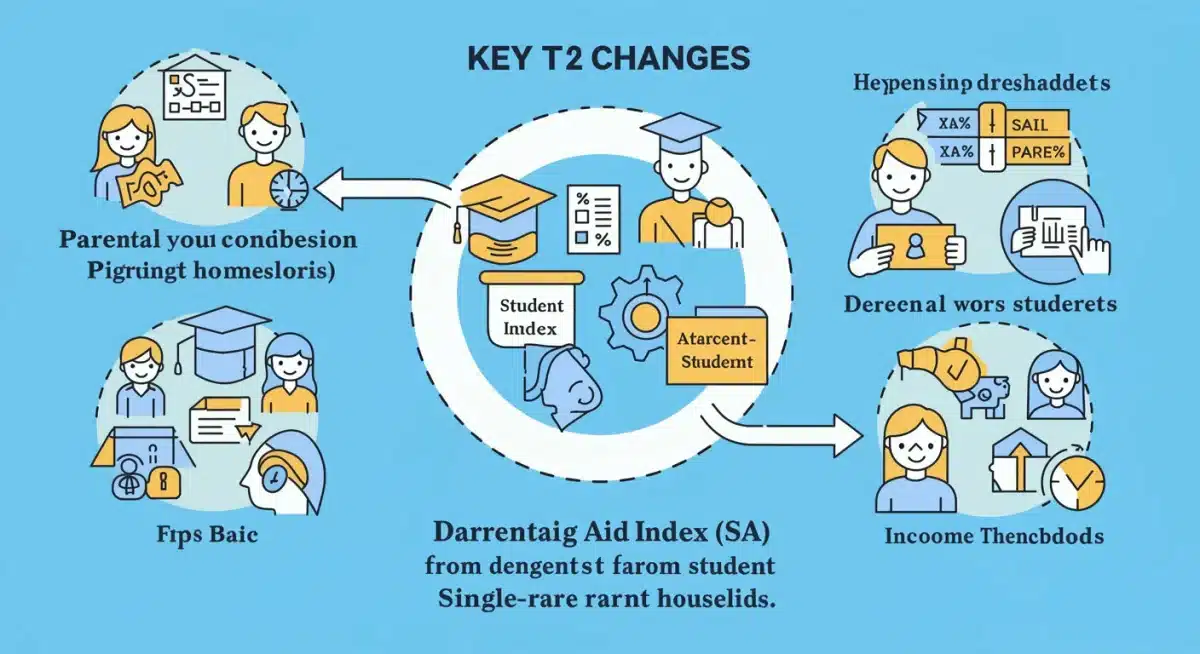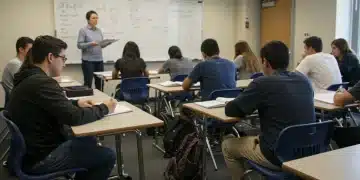Navigating 2025 FAFSA Changes: Single-Parent Aid Guide

The 2025 FAFSA introduces crucial changes impacting single-parent households seeking financial aid. This guide offers practical, step-by-step solutions to help these families navigate the new regulations and maximize their eligibility for essential educational funding.
The landscape of federal student financial aid is undergoing a significant overhaul for the 2025-2026 academic year, bringing both challenges and opportunities for single-parent households. Understanding and effectively navigating the 2025 FAFSA Changes: A Step-by-Step Guide for Single-Parent Households to Maximize Aid (PRACTICAL SOLUTIONS) is more critical than ever to ensure access to vital educational funding.
Understanding the FAFSA Simplification Act
The FAFSA Simplification Act, enacted by Congress, aims to streamline the financial aid application process and expand eligibility for federal student aid. While designed to simplify, the changes introduce new terminology and methodologies that require careful attention, especially for families with unique structures like single-parent households. As of recent developments, the Department of Education continues to release clarifications and guidance, underscoring the dynamic nature of these updates.
One of the most significant shifts is the replacement of the Expected Family Contribution (EFC) with the Student Aid Index (SAI). This new index is a key factor in determining a student’s financial need and, consequently, the amount of federal aid they qualify for. The SAI calculation is designed to be more equitable, but its implications for single-parent families warrant specific examination.
Key Changes to Know
- Student Aid Index (SAI): Replaces the EFC, offering a new framework for assessing financial need.
- Reduced FAFSA Questions: The application form itself is shorter and more user-friendly, moving from over 100 questions to approximately 36.
- Direct Data Exchange with IRS: Consent to retrieve federal tax information directly from the IRS will be mandatory, streamlining income verification.
- Expanded Pell Grant Eligibility: More students, including those from lower-income single-parent homes, are expected to qualify for Pell Grants.
Impact on Single-Parent Households: What’s Different?
For single-parent households, the 2025 FAFSA changes present both potential advantages and areas needing careful consideration. The new methodology for calculating the Student Aid Index (SAI) could lead to different aid eligibility outcomes compared to the previous EFC system. This is particularly relevant when considering the impact of child support payments and household size.
Previously, child support received was counted as untaxed income on the FAFSA, which could negatively affect aid eligibility. Under the new rules, child support received will no longer be reported as income, a change that is anticipated to be beneficial for many single-parent families. This adjustment aims to provide a more accurate picture of a family’s financial capacity and reduce artificial inflation of their income for aid calculation purposes.
Understanding Parental Contribution
The definition of ‘parent’ for FAFSA purposes has also been clarified. For dependent students whose parents are divorced or separated, the parent who provided the most financial support in the past 12 months will be the one whose financial information is reported on the FAFSA. This is a departure from the previous rule which focused on the parent with whom the student lived the most. This distinction is crucial for single parents to correctly identify which parent should complete the FAFSA and provide their financial data.
- Child Support Exclusion: Child support received is no longer reported as income, potentially increasing aid eligibility.
- Parent Definition: The parent providing the most financial support, not necessarily the custodial parent, completes the FAFSA.
- Household Size Calculation: The new FAFSA links household size directly to the number of tax exemptions claimed, which could differ from previous manual counts.

Step-by-Step Guide to Completing the New FAFSA
Completing the refreshed 2025 FAFSA requires a systematic approach to ensure accuracy and maximize aid potential. The application window is expected to open in December 2024, a change from the traditional October start, necessitating updated planning for single-parent households.
First, both the student and the contributing parent must create an FSA ID. This unique identifier is essential for accessing and signing the FAFSA electronically. It’s advisable to create these IDs well in advance of the application opening, as verification can take a few days. Ensure all personal information, including social security numbers, is accurate and readily available.
Next, gather all necessary financial documents. This includes federal tax returns for the prior-prior year (for the 2025-2026 FAFSA, this will be 2023 tax information), W-2 forms, and records of any untaxed income. While child support received is no longer reported as income, other untaxed income sources might still be relevant. The FAFSA’s direct data exchange with the IRS (Direct Data Release) will simplify reporting, but having your documents on hand helps verify the information.
Essential FAFSA Steps for Single Parents
- Create FSA IDs: Both student and contributing parent need an FSA ID.
- Gather Documents: Collect 2023 tax returns, W-2s, and other income records.
- Identify Contributing Parent: Determine who provided the most financial support.
- Consent to IRS Data Retrieval: Grant permission for the FAFSA to access your tax data. This is mandatory.
- Complete the Application: Fill out the FAFSA carefully, paying close attention to household size and asset questions.
Maximizing Aid: Strategic Planning and Resources
Beyond simply filling out the FAFSA, single-parent households can employ several strategies to maximize their financial aid. Understanding the nuances of the Student Aid Index (SAI) and how assets are treated can make a significant difference in aid eligibility. For instance, assets held in retirement accounts are generally not counted in the SAI calculation, whereas non-retirement investment accounts are.
It is also important to explore all available aid types. Federal Pell Grants, Federal Supplemental Educational Opportunity Grants (FSEOG), and federal student loans are primary sources. However, state grants, institutional scholarships, and private scholarships can significantly supplement federal aid. Many institutions offer specific scholarships for single parents or students from single-parent households, and active research into these opportunities is highly recommended.
Additionally, consider the impact of financial circumstances changes. If a single parent experiences a significant loss of income or unexpected medical expenses after submitting the FAFSA, they can appeal their financial aid package. This process, known as ‘professional judgment,’ allows financial aid administrators to adjust a student’s aid eligibility based on special circumstances not captured by the initial FAFSA application. Documentation of these changes is crucial for a successful appeal.
Leveraging Available Support
- Research Scholarships: Look for institutional and private scholarships, especially those for single-parent families.
- Understand Asset Impact: Differentiate between countable and non-countable assets for SAI calculation.
- Consider Professional Judgment: Appeal for aid adjustments if financial circumstances change significantly.
- Utilize Campus Resources: Many colleges offer dedicated support services and financial aid advisors.
Common Pitfalls and How to Avoid Them
Even with the simplified FAFSA, single-parent households can encounter specific challenges that might hinder their aid potential. One common pitfall is misunderstanding the ‘contributing parent’ definition. As previously noted, it’s the parent who provided the most financial support, not necessarily the parent with whom the student primarily lives. Incorrectly identifying this parent can lead to delays or inaccuracies in aid calculations.
Another frequent error is failing to consent to the direct data exchange with the IRS. This consent is now mandatory, and without it, the FAFSA application cannot be fully processed, potentially delaying or preventing aid disbursement. Ensuring that all parties involved (student and contributing parent) provide this consent promptly is critical. Furthermore, incomplete or inaccurate information regarding household size or assets can also lead to issues. Reviewing the application thoroughly before submission is essential.
Additionally, missing deadlines is a significant obstacle. While the federal FAFSA deadline is typically later in the academic year, states and individual colleges often have much earlier priority deadlines for their own grant and scholarship programs. Single parents should research and mark all relevant deadlines to avoid missing out on crucial funding opportunities. Keeping a detailed calendar of these dates can be a simple yet effective preventative measure.
Avoiding FAFSA Application Errors
- Verify Contributing Parent: Double-check who provided the most financial support.
- Grant IRS Consent: Ensure mandatory consent for data retrieval is provided.
- Check Deadlines: Be aware of federal, state, and institutional deadlines.
- Review Thoroughly: Proofread all information before submitting the FAFSA.
- Seek Assistance: Don’t hesitate to contact financial aid offices for clarification.
Future Outlook and Continued Advocacy
The 2025 FAFSA changes represent a significant evolution in federal student aid, and while they aim to simplify the process and expand access, the journey is ongoing. The Department of Education continues to refine its systems and provide guidance, indicating that further adjustments or clarifications may emerge. For single-parent households, staying informed about these developments is paramount to successfully navigating the financial aid landscape.
Advocacy for single-parent families in higher education remains vital. Organizations and policymakers continue to work towards ensuring that financial aid policies adequately support the unique challenges faced by these households. As the new FAFSA system matures, data will emerge to assess its true impact, potentially leading to further refinements. Engaging with college financial aid offices and advocacy groups can provide valuable insights and support.
Ultimately, the goal is to ensure that educational opportunities are accessible to all, regardless of family structure. The current changes are a step in that direction, but continuous vigilance and proactive engagement from single-parent households will be key to unlocking the full potential of available financial aid. The commitment to higher education for children in single-parent families is a collective effort, requiring ongoing attention to policy, resources, and practical application strategies.
| Key Point | Brief Description |
|---|---|
| SAI Replaces EFC | The Student Aid Index (SAI) now assesses financial need, replacing the Expected Family Contribution (EFC). |
| Child Support Exclusion | Child support received is no longer counted as income, potentially boosting aid eligibility for single parents. |
| Contributing Parent Defined | The parent providing most financial support completes the FAFSA, not necessarily the custodial parent. |
| Mandatory IRS Data Exchange | Consent to retrieve tax data directly from the IRS is now required for FAFSA processing. |
Frequently Asked Questions About 2025 FAFSA Changes
The SAI is a new metric replacing the EFC, designed to more accurately assess a student’s financial need. Unlike the EFC, the SAI can be a negative number, indicating a higher level of financial need. It aims to simplify calculations and expand Pell Grant eligibility, especially for lower-income families.
For the 2025 FAFSA, child support received is no longer reported as income. This is a significant change that is expected to benefit single-parent households by potentially increasing their eligibility for federal financial aid, as it removes a factor that previously reduced aid.
For dependent students with divorced or separated parents, the FAFSA should be completed by the parent who provided the most financial support to the student during the past 12 months. This is a shift from the previous rule based on the custodial parent.
Yes, consenting to the direct data exchange with the IRS is mandatory for both the student and the contributing parent. Without this consent, the FAFSA application cannot be fully processed, which could prevent the student from receiving federal financial aid.
The 2025 FAFSA is expected to open in December 2024. While the federal deadline is later, single-parent households should aim to submit as early as possible. State and institutional aid often have earlier priority deadlines, and funds can be limited, so prompt submission is crucial.
Looking Ahead: Sustained Support for Single-Parent Families
The implementation of the 2025 FAFSA changes marks a pivotal moment for financial aid, particularly for single-parent households. As the Department of Education continues its rollout, vigilance and adaptability will be key. Further guidance and potential adjustments are anticipated as the new system integrates fully. Single-parent families should remain proactive, utilizing available resources and seeking clarification from financial aid professionals to ensure they can effectively navigate these changes and secure the maximum possible aid for their educational pursuits. The focus remains on making higher education more accessible, and sustained engagement with these evolving policies is crucial for success.





